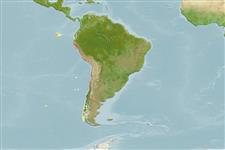>
Blenniiformes (Blennies) >
Blenniidae (Combtooth blennies) > Salariinae
Etymology: Scartichthys: Greek, skaritis, -idos = a jewel stone with the colour of the fish scarus (Ref. 45335); viridis: Latin, viridis = green; refers to the green body coloration in life (Ref. 10696).
More on author: Valenciennes.
Environment: milieu / climate zone / depth range / distribution range
Ecologia
marino demersale; distribuzione batimetrica 0 - 10 m (Ref. 10696). Subtropical
Southeast Pacific: Independencia Bay, Peru to Valparaiso, Chile.
Size / Peso / Age
Maturity: Lm ? range ? - ? cm
Max length : 19.7 cm SL maschio/sesso non determinato; (Ref. 10696)
Spine dorsali (totale): 12; Raggi dorsali molli (totale): 17-19; Spine anali 2; Raggi anali molli: 19 - 20. Distinctive in having a relatively uniformly pigmented body without spots; further differentiated from S. gigas and S. variolatus in having a high number of dentary teeth, 106-131 (versus 93 or fewer).
Adults are found in tide pools and rocky shore areas. Are primarily herbivorous (Ref. 9032). Selectively feed on the green algae Ulva, Enteromorpha, as juveniles and favor red algae Gelidium as adults (Ref. 94105). Oviparous. Eggs are demersal and adhesive (Ref. 205), and are attached to the substrate via a filamentous, adhesive pad or pedestal (Ref. 94114). Larvae are planktonic, often found in shallow, coastal waters (Ref. 94114).
Life cycle and mating behavior
Maturità | Riproduzione | Deposizione | Uova | Fecundity | Larve
Oviparous, distinct pairing (Ref. 205).
Williams, J.T., 1990. Phylogenetic relationships and revision of the blenniid fish genus Scartichthys. Smith. Contrib. Zool. 492:1-30. (Ref. 10696)
IUCN Red List Status (Ref. 130435)
Threat to humans
Harmless
Human uses
Informazioni ulteriori
BibliografiaAcquacolturaProfilo di acquacolturaVarietàGeneticaElectrophoresesEreditarietàMalattieElaborazioneNutrientsMass conversion
CollaboratoriImmaginiStamps, Coins Misc.SuoniCiguateraVelocitàModalità di nuotoArea branchialeOtolithsCervelliVista
Strumenti
Special reports
Download XML
Fonti Internet
Estimates based on models
Preferred temperature (Ref.
123201): 14.8 - 20.6, mean 19.5 °C (based on 102 cells).
Phylogenetic diversity index (Ref.
82804): PD
50 = 0.5625 [Uniqueness, from 0.5 = low to 2.0 = high].
Bayesian length-weight: a=0.00661 (0.00340 - 0.01283), b=2.96 (2.79 - 3.13), in cm total length, based on LWR estimates for this species & (Sub)family-body (Ref.
93245).
Trophic level (Ref.
69278): 2.2 ±0.1 se; based on diet studies.
Resilienza (Ref.
120179): Medio, tempo minimo di raddoppiamento della popolazione 1.4 - 4.4 anni (Assuming tm=1 and Fec=100-1000).
Fishing Vulnerability (Ref.
59153): Low vulnerability (14 of 100).
Nutrients (Ref.
124155): Calcium = 172 [83, 366] mg/100g; Iron = 1.23 [0.71, 2.35] mg/100g; Protein = 18 [17, 19] %; Omega3 = 0.175 [0.091, 0.332] g/100g; Selenium = 16.5 [7.7, 38.1] μg/100g; VitaminA = 16.7 [4.3, 63.8] μg/100g; Zinc = 1.4 [0.9, 2.1] mg/100g (wet weight);
